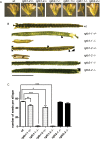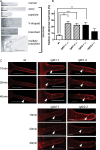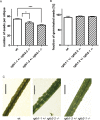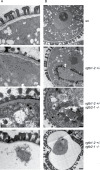Rab geranylgeranyl transferase β subunit is essential for male fertility and tip growth in Arabidopsis
- PMID: 25316062
- PMCID: PMC4265159
- DOI: 10.1093/jxb/eru412
Rab geranylgeranyl transferase β subunit is essential for male fertility and tip growth in Arabidopsis
Abstract
Rab proteins, key players in vesicular transport in all eukaryotic cells, are post-translationally modified by lipid moieties. Two geranylgeranyl groups are attached to the Rab protein by the heterodimeric enzyme Rab geranylgeranyl transferase (RGT) αβ. Partial impairment in this enzyme activity in Arabidopsis, by disruption of the AtRGTB1 gene, is known to influence plant stature and disturb gravitropic and light responses. Here it is shown that mutations in each of the RGTB genes cause a tip growth defect, visible as root hair and pollen tube deformations. Moreover, FM 1-43 styryl dye endocytosis and recycling are affected in the mutant root hairs. Finally, it is demonstrated that the double mutant, with both AtRGTB genes disrupted, is non-viable due to absolute male sterility. Doubly mutated pollen is shrunken, has an abnormal exine structure, and shows strong disorganization of internal membranes, particularly of the endoplasmic reticulum system.
Keywords: Arabidopsis; Rab geranylgeranyl transferase; Rab protein; male fertility; pollen; pollen tube; protein prenylation; root hair; tip growth..
© The Author 2014. Published by Oxford University Press on behalf of the Society for Experimental Biology.
Figures







Similar articles
-
The Rab Geranylgeranyl Transferase Beta Subunit Is Essential for Embryo and Seed Development in Arabidopsis thaliana.Int J Mol Sci. 2021 Jul 24;22(15):7907. doi: 10.3390/ijms22157907. Int J Mol Sci. 2021. PMID: 34360673 Free PMC article.
-
Arabidopsis RAB geranylgeranyl transferase beta-subunit mutant is constitutively photomorphogenic, and has shoot growth and gravitropic defects.Plant J. 2010 May 1;62(4):615-27. doi: 10.1111/j.1365-313X.2010.04172.x. Epub 2010 Feb 18. Plant J. 2010. PMID: 20180921
-
Impact of C-terminal truncations in the Arabidopsis Rab escort protein (REP) on REP-Rab interaction and plant fertility.Plant J. 2021 Dec;108(5):1400-1421. doi: 10.1111/tpj.15519. Epub 2021 Oct 16. Plant J. 2021. PMID: 34592024 Free PMC article.
-
Structure, regulation and cellular functions of Rab geranylgeranyl transferase and its cellular partner Rab Escort Protein.Mol Membr Biol. 2012 Nov;29(7):243-56. doi: 10.3109/09687688.2012.693211. Epub 2012 Jun 14. Mol Membr Biol. 2012. PMID: 22694141 Review.
-
How many receptor-like kinases are required to operate a pollen tube.Curr Opin Plant Biol. 2018 Feb;41:73-82. doi: 10.1016/j.pbi.2017.09.008. Epub 2017 Oct 6. Curr Opin Plant Biol. 2018. PMID: 28992536 Review.
Cited by
-
Arabidopsis Rab Geranylgeranyltransferases Demonstrate Redundancy and Broad Substrate Specificity in Vitro.J Biol Chem. 2016 Jan 15;291(3):1398-410. doi: 10.1074/jbc.M115.673491. Epub 2015 Nov 20. J Biol Chem. 2016. PMID: 26589801 Free PMC article.
-
Screening of Differentially Expressed Genes and Localization Analysis of Female Gametophyte at the Free Nuclear Mitosis Stage in Pinus tabuliformis Carr.Int J Mol Sci. 2022 Feb 8;23(3):1915. doi: 10.3390/ijms23031915. Int J Mol Sci. 2022. PMID: 35163836 Free PMC article.
-
Functional Gene Network of Prenyltransferases in Arabidopsis thaliana.Molecules. 2019 Dec 12;24(24):4556. doi: 10.3390/molecules24244556. Molecules. 2019. PMID: 31842481 Free PMC article. Review.
-
Male functions and malfunctions: the impact of phosphoinositides on pollen development and pollen tube growth.Plant Reprod. 2016 Jun;29(1-2):3-20. doi: 10.1007/s00497-015-0270-6. Epub 2015 Dec 16. Plant Reprod. 2016. PMID: 26676144 Review.
-
The Rab Geranylgeranyl Transferase Beta Subunit Is Essential for Embryo and Seed Development in Arabidopsis thaliana.Int J Mol Sci. 2021 Jul 24;22(15):7907. doi: 10.3390/ijms22157907. Int J Mol Sci. 2021. PMID: 34360673 Free PMC article.
References
-
- Boavida LC, McCormick S. 2007. Temperature as a determinant factor for increased and reproducible in vitro pollen germination in Arabidopsis thaliana. The Plant Journal 52, 570–582. - PubMed
-
- Camacho L, Smertenko AP, Perez-Gomez J, Hussey PJ, Moore I. 2009. Arabidopsis Rab-E GTPases exhibit a novel interaction with a plasma-membrane phosphatidylinositol-4-phosphate 5-kinase. Journal of Cell Science 122, 4383–4392. - PubMed
-
- Cheung AY, Wu HM. 2008. Structural and signaling networks for the polar cell growth machinery in pollen tubes. Annual Review of Plant Biology 59, 547–572. - PubMed
-
- Cole RA, Fowler JE. 2006. Polarized growth: maintaining focus on the tip. Current Opinion in Plant Biology 9, 579–588. - PubMed
Publication types
MeSH terms
Substances
LinkOut - more resources
Full Text Sources
Other Literature Sources
Molecular Biology Databases

